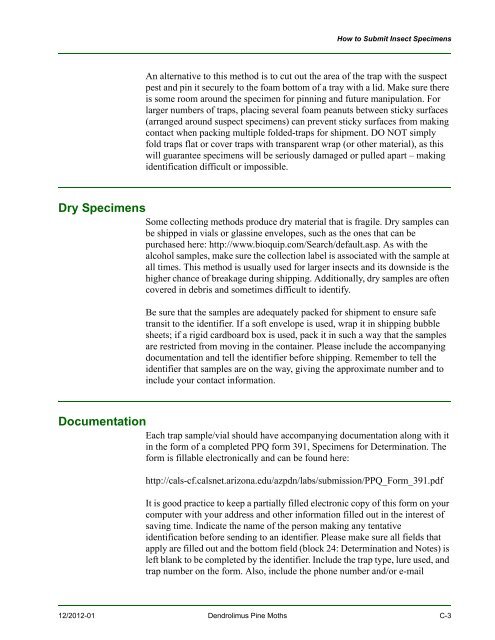New Pest Response Guidelines - aphis - US Department of Agriculture
New Pest Response Guidelines - aphis - US Department of Agriculture
New Pest Response Guidelines - aphis - US Department of Agriculture
Create successful ePaper yourself
Turn your PDF publications into a flip-book with our unique Google optimized e-Paper software.
How to Submit Insect Specimens<br />
An alternative to this method is to cut out the area <strong>of</strong> the trap with the suspect<br />
pest and pin it securely to the foam bottom <strong>of</strong> a tray with a lid. Make sure there<br />
is some room around the specimen for pinning and future manipulation. For<br />
larger numbers <strong>of</strong> traps, placing several foam peanuts between sticky surfaces<br />
(arranged around suspect specimens) can prevent sticky surfaces from making<br />
contact when packing multiple folded-traps for shipment. DO NOT simply<br />
fold traps flat or cover traps with transparent wrap (or other material), as this<br />
will guarantee specimens will be seriously damaged or pulled apart – making<br />
identification difficult or impossible.<br />
Dry Specimens<br />
Some collecting methods produce dry material that is fragile. Dry samples can<br />
be shipped in vials or glassine envelopes, such as the ones that can be<br />
purchased here: http://www.bioquip.com/Search/default.asp. As with the<br />
alcohol samples, make sure the collection label is associated with the sample at<br />
all times. This method is usually used for larger insects and its downside is the<br />
higher chance <strong>of</strong> breakage during shipping. Additionally, dry samples are <strong>of</strong>ten<br />
covered in debris and sometimes difficult to identify.<br />
Be sure that the samples are adequately packed for shipment to ensure safe<br />
transit to the identifier. If a s<strong>of</strong>t envelope is used, wrap it in shipping bubble<br />
sheets; if a rigid cardboard box is used, pack it in such a way that the samples<br />
are restricted from moving in the container. Please include the accompanying<br />
documentation and tell the identifier before shipping. Remember to tell the<br />
identifier that samples are on the way, giving the approximate number and to<br />
include your contact information.<br />
Documentation<br />
Each trap sample/vial should have accompanying documentation along with it<br />
in the form <strong>of</strong> a completed PPQ form 391, Specimens for Determination. The<br />
form is fillable electronically and can be found here:<br />
http://cals-cf.calsnet.arizona.edu/azpdn/labs/submission/PPQ_Form_391.pdf<br />
It is good practice to keep a partially filled electronic copy <strong>of</strong> this form on your<br />
computer with your address and other information filled out in the interest <strong>of</strong><br />
saving time. Indicate the name <strong>of</strong> the person making any tentative<br />
identification before sending to an identifier. Please make sure all fields that<br />
apply are filled out and the bottom field (block 24: Determination and Notes) is<br />
left blank to be completed by the identifier. Include the trap type, lure used, and<br />
trap number on the form. Also, include the phone number and/or e-mail<br />
12/2012-01 Dendrolimus Pine Moths C-3

















